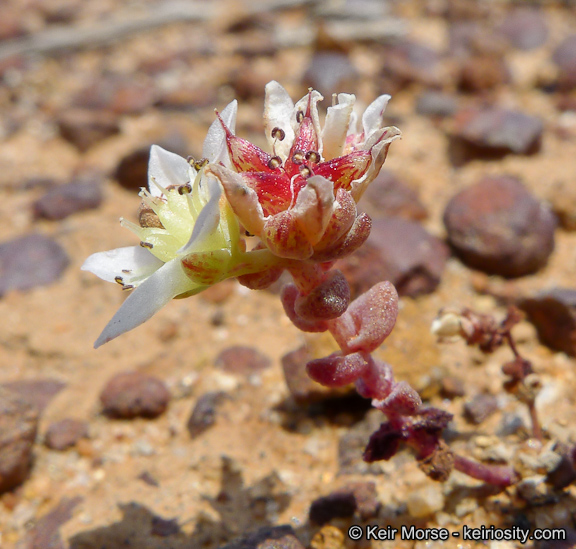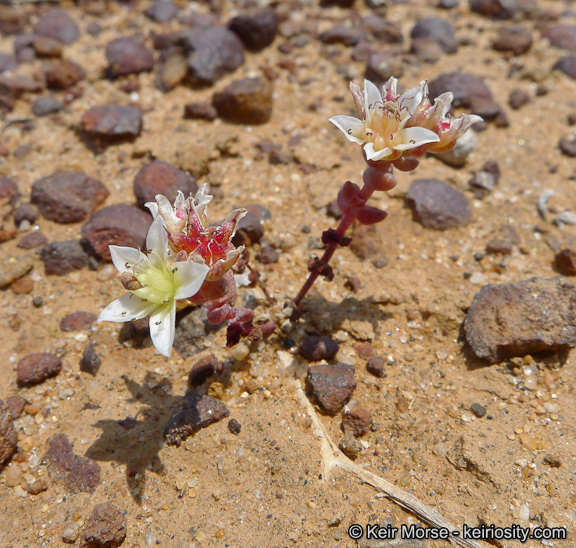
Short-leaved Dudleya
Dudleya brevifolia
Dudleya brevifolia

Short-leaved Dudleya
Dudleya brevifolia
Dudleya brevifolia
Goal: Maintain or enhance existing Short-leaved dudleya occurrences to ensure multiple conserved occurrences with self sustaining populations to increase resilience to environmental and demographic stochasticity, maintain genetic diversity, and ensure persistence over the long term (>100 years) in chaparral vegetation communities.
Management units: 6, 7
In 2017, continue annual inspections of short-leaved dudleya on Conserved Lands in (see occurrence table) using the regional rare plant IMG monitoring protocol to record abundance and collect covariate habitat and threats data to determine management needs.
| Action | Statement | Action status | Projects |
|---|---|---|---|
| IMP-1 | Based upon occurrence status and threats, determine management needs including whether routine management or more intensive management is warranted. | available for implementation | |
| IMP-2 | Submit project metadata, monitoring datasets and management recommendations to the MSP Web Portal. | available for implementation |
| Criteria | Deadline year |
|---|---|
| Surveys Completed Every Year with Management Recommendations | 2021 |
| Threat Name | Threat Code |
|---|---|
| Human uses of the Preserves | HUMUSE |
| Invasive plants | INVPLA |
| Urban development | URBDEV |
Management units: 6, 7
Beginning in 2017, conduct routine management actions identified through the annual IMG monitoring at short leaved dudleya occurrences on Conserved Lands in (see occurrence table). Depending on the type and level of threat, management should only be conducted as needed, not necessarily every year, and using BMPs with precautions to do no harm.
| Action | Statement | Action status | Projects |
|---|---|---|---|
| IMP-1 | Perform routine management activities as needed, such as protecting occurrences from disturbance through enforcement and controlling invasive non-native plant species to at most 20% absolute cover. | available for implementation | Otay Mesa Rare Plants |
| IMP-2 | Submit project metadata and management data to the MSP Web Portal. | available for implementation | Otay Mesa Rare Plants |
| Criteria | Deadline year |
|---|---|
| Routine Management Completed as Needed Based Upon Monitoring Recommendations | 2021 |
| Threat Name | Threat Code |
|---|---|
| Human uses of the Preserves | HUMUSE |
| Invasive plants | INVPLA |
| Urban development | URBDEV |
Management units: 6, 7
In 2021, begin preparing a section for short-leaved dudleya in the MSP Seed Collection, Banking and Bulking Plan to preserve genetic diversity and rescue occurrences in case of catastrophic disturbance. The plan should incorporate best science and management practices (Wall 2009, KEW 2016) and recommendations from the genetic study to provide guidelines for collecting and storing seeds over the long term at a permanent, established conservation seed bank (e.g., Institute for Conservation Research Native Plant Seed Bank, Rancho Santa Ana Botanic Garden Seed Conservation Program) and to provide seed sources for management purposes. The plan should include recommendations for: collecting and storing seeds for conservation banking; management oriented research; rescuing occurrences after catastrophic disturbances; and seed bulking and out-planting to augment extant occurrences or to establish new occurrences with consideration of genetic implications for population sustainability.
| Action | Statement | Action status | Projects |
|---|---|---|---|
| PRP-1 | Consult the San Diego County Rare Plant Working Group made up of plant ecologists, geneticists, rare plant experts, land managers, restoration practitioners, seed banking and bulking practitioners, wildlife agencies, and other stakeholders to provide input and recommendations for the short-leaved dudleya section of the MSP Seed Collection, Banking and Bulking Plan. | on hold | |
| PRP-2 | Prepare a seed collection plan to collect seeds over multiple years, collect seeds several times within a season, accumulate seeds across populations, and to sample among habitats and ecological niches. Include guidelines for collecting and storing seeds along maternal lines from small occurrences (<1,000 plants) and to provide propagules to be used in management experiments, enhancement of existing occurrences, and establishment of new occurrences. | on hold | |
| PRP-3 | The seed collection plan should include guidelines for collecting seeds from occurrences of sufficient size to accommodate harvest and based on genetic studies as available. Include provisions for collecting seed from unconserved populations planned for development. | on hold | |
| PRP-4 | Include protocols and guidelines for collecting voucher specimens and submitting to the San Diego Natural History Museum (McEachern et al. 2007). | on hold | |
| PRP-5 | Include guidelines for testing seeds for viability and to obtain information on dormancy and germination rates. | on hold | |
| PRP-6 | Submit project metadata and MSP Seed Collection, Banking and Bulking Plan to MSP Web Portal. | on hold |
| Criteria | Deadline year |
|---|---|
| By 2022, Completed Short-leaved dudleya Section in the MSP Seed Collection, Banking and Bulking Plan | 2021 |
| Threat Name | Threat Code |
|---|---|
| Human uses of the Preserves | HUMUSE |
| Invasive plants | INVPLA |
| Urban development | URBDEV |
Management units: 6, 7
In 2021, begin preparing a section for short-leaved dudleya in the MSP Rare Plant Management Plan that prioritizes management actions to maintain or expand conserved occurrences based upon an assessment of data on occurrence status habitat and threats. Include recommendations for short-leaved dudleay from MSP Seed Collection, Banking and Bulking Plan, relevant BMPs, and recommendations for monitoring effectiveness of management actions.
| Action | Statement | Action status | Projects |
|---|---|---|---|
| PRP-1 | Consult the San Diego County Rare Plant Working Group made up of plant ecologists, geneticists, rare plant experts, land managers, restoration practitioners, seed banking and bulking practitioners, wildlife agencies, and other stakeholders to provide input and recommendations for short-leaved dudleya in the MSP Rare Plant Management Plan. | on hold | |
| PRP-2 | Develop a conceptual model that identifies management actions to effectively reduce threats to short-leaved dudleya occurrences. | on hold | |
| PRP-3 | Prioritize occurrences for management based upon an assessment of occurrence size, the potential for management to significantly reduce identified threats, and the availability of adjacent suitable habitat for occurrence expansion. | on hold | |
| PRP-4 | Develop an implementation plan for short-leaved dudleya that prioritizes management actions for the next 5 years and details tasks, lead entities, responsibilities, and timelines, budgets. | on hold | |
| PRP-5 | Submit project metadata and MSP Rare Plant Management Plan to the MSP Web Portal. |
| Criteria | Deadline year |
|---|---|
| By 2022, Completed Short-leaved dudleya section in the MSP Rare Plant Management Plan | 2021 |
| Threat Name | Threat Code |
|---|---|
| Human uses of the Preserves | HUMUSE |
| Invasive plants | INVPLA |
| Urban development | URBDEV |
|
Rare Plant Inspect and Manage Monitoring 2014-2026
From 2014-2026, a Management and Monitoring Strategic Plan (MSP Roadmap) monitoring objective for 30 rare plant species is to inspect occurrences to determine management needs. The inspect and manage (IMG) objective is implemented to document the status of rare plant occurrences and assess habitats and threats to develop specific management recommendations. IMG monitoring is implemented by a combination of land managers and contracted biologists in coordination with the SDMMP. Available rare plant data is posted below. New annual updates are typically posted in March. Based upon an evaluation of these data, a 2014-2026 monitoring schedule has been developed for the 30 rare plant species (attached below). Coordinating data collection across the region allows analyses of species and population trends over time and provides a better understanding of the association between habitat and threat covariates and population dynamics.
|
|
Rare Plant Management and Seed Plan
MSP Roadmap 2019 and 2020 objectives include developing a Management Strategic Plan Framework Rare Plant Management Plan for Conserved Lands in Western San Diego County and a Management Strategic Plan Seed Collection, Banking, and Bulking Plan for Conserved Lands in Western San Diego County. These plans include general sections with background information and rationale for prioritizing and developing management recommendations with separate chapters and specific recommendations for priority species. In 2019, general framework sections were developed along with species chapters for San Diego thornmint, Nuttall's acmispon, salt marsh bird's-beak and Otay tarplant (CBI, AECOM and SDMMP 2020 a,b). In 2020, chapters will be developed for short-leaved dudleya, Orcutt's spineflower, and willowy monardella. These plans are developed with input and guidance provided by the Rare Plant Management Group Steering Committee and species working groups. Participants in these groups include landowners and managers, scientists, species experts, restoration specialists, seed collection and banking practitioners, and representatives from non-profit organizations and wildlife agencies. These plans are based on the latest scientific information for species on habitat relationships, ecology, genetics, seed collection guidelines, and best management practices. Occurrence-specific management recommendations are based on working group input and multiple years of Inspect and Manage monitoring data on population status, habitat associations and threats. These are living documents as new species chapters are added as they are developed and existing chapters are revised when new information becomes available or management actions are completed, and new recommendations are needed.
|
Endemic to San Diego County occurring only along the coast between Del Mar and La Jolla [1].
There are five occurrences of this species, including an occurrence in MU 6 at Carmel Mountain Preserve and four occurrences in MU 7 at Crest Canyon, Skeleton Canyon, Torrey Pines State Reserve, and Torrey Pines Extension [2].
CE
Occurs on sandstone bluffs and in sandy openings in chamise chaparral on Carlsbad gravelly loam soils in association with small iron concretions [1,3]. It is often in areas with native annual forbs and while not a wetland species it occurs in areas where soils remain saturated for a relatively long period after rain [4].
in the family Crassulaceae.
Herbaceous perennial [5].
Large annual fluctuations in population size [5].
Pollinated by insects [6]. Seeds are thought to be self-dispersed.
Trampling by hikers, bikers, dogs and horses, illegal trails, invasive non-native plants and erosion [7]. A small number of occurrences in close proximity make the species vulnerable to loss from catastrophic disturbance and environmental stochasticity.
Special considerations: Very small and can be difficult to detect when not flowering [5].
[1] Reiser, C. 1994. Rare Plants of San Diego County. http://sandiego.sierraclub.org/rareplants/ Accessed 2012 and 2013.
[2] MSP-MOM. 2013. Management Strategic Plan Master Occurrence Matrix. http://www.sdmmp.com/Home.aspx
[3] RECON. 2009. Carmel Mountain and Del Mar Mesa Preserves Resource Management Plan. Prepared for the City of San Diego. RECON Number 3493-1B.
[4] City of San Diego. In prep. Dudleya brevifolia Restoration Plan.
[5] McEachern, K., B. Pavlik, J. Rebman, and R. Sutter. 2010a. Assessment of Eleven Years of Rare Plant Monitoring Data from the San Diego Multiple Species Conservation Plan. USGS-WERC-Channel Islands Field Station Administrative Report 2010-01, Ventura, CA.
[6] SANDAG. 2003. Volume II: Final MHCP Plan Biological Analysis and Permitting Conditions. Prepared by AMEC Earth and Environmental, Inc., Conservation Biology Institute, and AMEC. Prepared for the Multiple Habitat Conservation Program administered by the San Diego Association of Governments (SANDAG).
[7] City of San Diego. 2001-2006, 2009-2012. Rare Plant Monitoring Data. http://www.sandiego.gov/planning/programs/mscp/pdf/monitor/monitoringsummary1999to2009.pdf